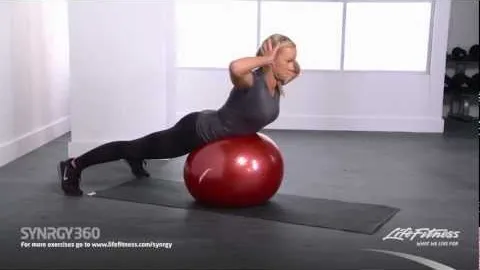



Stability Ball Back Extensions: Strengthen Your Core and Improve Posture
Are you looking for an effective exercise to strengthen your core and improve your posture? Stability ball back extensions might be just what you need. This exercise is a great way to target the muscles in your lower back and engage your core stabilizers. In this article, we will dive into the benefits, proper technique, variations, and safety tips for stability ball back extensions.
Stability ball back extensions come with a multitude of benefits for your body and overall fitness. Let’s explore some of the advantages that this exercise can offer:
1. Core Strength and Stability: By curling your body backward against the resistance of the stability ball, you are engaging your core muscles, including your abdominals and obliques. This exercise targets your deep core stabilizers, which help to improve overall balance and stability.
2. Lower Back Strength: Stability ball back extensions primarily target the erector spinae muscles located in your lower back. These muscles play a crucial role in maintaining a healthy and stable spine. By strengthening the erector spinae, you can improve your posture and reduce the risk of lower back pain.
3. Hip Mobility: As you perform stability ball back extensions, you will also engage the muscles in your glutes and hamstrings. This exercise helps to improve hip mobility and can be beneficial for individuals who spend long hours sitting or have sedentary lifestyles.
4. Improved Posture: Regularly practicing stability ball back extensions can help correct poor posture by strengthening the muscles that support the spine. By strengthening your core and back muscles, you encourage proper alignment and reduce the likelihood of slouching or hunching forward.
5. Increased Flexibility: Stability ball back extensions require a certain range of motion in your lower back. By consistently performing this exercise, you can improve the flexibility of your lower back, leading to better movement patterns and reduced muscle imbalances.
To get the most out of stability ball back extensions, it is crucial to execute the exercise with proper form and technique. Follow these step-by-step instructions to perform this exercise effectively:
Start by positioning yourself face down on a stability ball, ensuring that it is placed beneath your hips and lower abdomen. Position your feet hip-width apart on the ground for stability.
Place your hands lightly on the sides of your head or across your chest, depending on your preference. Keep your elbows slightly bent throughout the movement.
Engage your core and gluteal muscles to stabilize your body. This will help maintain proper alignment and prevent strain on your lower back.
Slowly contract your lower back muscles, lifting your torso off the ball and extending your spine. Maintain a neutral neck position, avoiding excessive backward bending.
Hold the extended position for a few seconds, focusing on squeezing your glutes and keeping your core engaged.
Lower your upper body back down onto the stability ball in a controlled manner, returning to the starting position.
Repeat the exercise for the recommended number of repetitions, keeping your movements slow and controlled throughout.
To add variety to your workout routine or target specific muscle groups, you can try different variations of stability ball back extensions. Here are a few examples:
Weighted Stability Ball Back Extensions: Hold a weight plate against your chest while performing the back extensions to increase the intensity and challenge your core and back muscles further.
Single Leg Stability Ball Back Extensions: Lift one leg off the ground while performing the back extensions to further engage your gluteal muscles and improve stability.
Hyperextension on a Stability Ball: Position yourself on the stability ball facing upward, with your feet anchored against a wall or ask someone to hold them. Gradually lower your upper body down and then lift it back up, focusing on your lower back muscles.
As with any exercise, it is essential to prioritize safety while performing stability ball back extensions. Consider the following tips to minimize the risk of injury:
Start Slow: If you are new to stability ball back extensions or have a history of lower back issues, start with a minimal range of motion and gradually increase it as your strength and flexibility improve.
Maintain Proper Alignment: Keep your body aligned throughout the exercise, avoiding excessive arching or rounding of the spine. Engage your core and gluteal muscles to support your posture.
Avoid Overextension: While it is important to extend your spine, avoid hyperextending or going beyond your natural range of motion. Overextending can strain the lower back and lead to discomfort or injury.
Consult a Professional: If you are unsure about the proper form or have pre-existing conditions, consult with a qualified fitness professional or healthcare provider before attempting stability ball back extensions.
In conclusion, stability ball back extensions are an effective exercise for strengthening your core, improving your posture, and enhancing your overall fitness. By incorporating this exercise into your routine with proper technique, you can experience the numerous benefits it has to offer. Remember to start slowly, listen to your body, and seek guidance if needed. Now, it's time to grab a stability ball and give stability ball back extensions a try!
If you're looking for a gym, fitness club or yoga studio, you've come to the right place.
You can find information about gyms in your area. Browse catalog of gyms and find gyms with classes which are you looking for.
On gym page you can find simple information like address, phone or website. You can find list of available classes. You can check availability of personal training or small group classes. On place page you can also see information about open hours.
You can find gyms near you with amenities, courts, studios and equipments.
Use our map to find gym at your city or district.
In Gym Navigator you can find list of exercises with movies for many body parts.
You can browse exercises catalog and find exercises the best of you.
You can also find exercises grouped into workout plans, which you can use to improve you body. Each routine show you exercises one by one and give you possibility to count you progress and count down rest time.